Unlike other Japanese salads like potato salad, ohitashi salad, or sunomono salad that require careful timing and technique, I believe kani salad should be extremely simple.
This three-step method builds layers of umami while maintaining that signature crunch you crave.
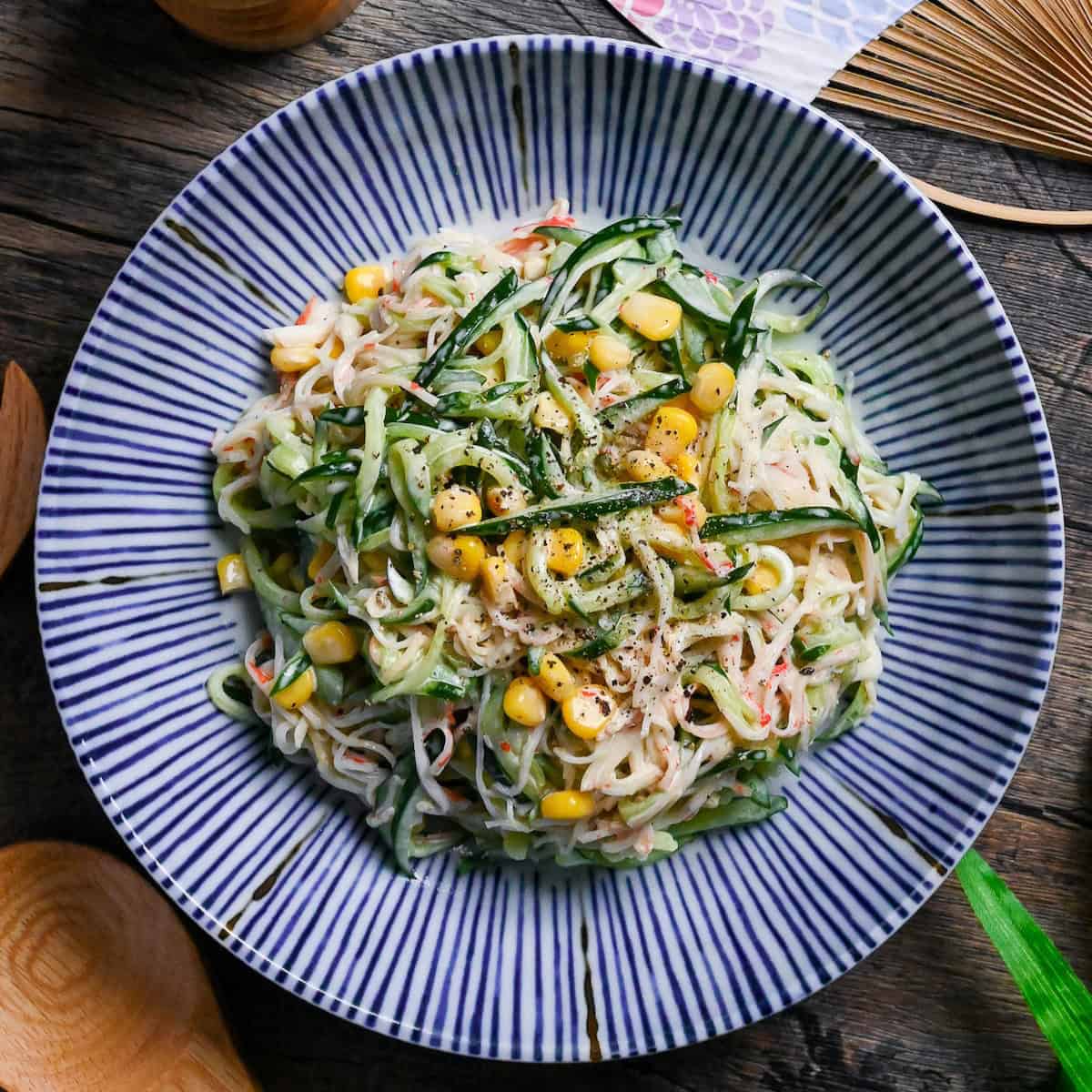
Kani Salad
Recipe Snapshot
- What is it? No-fuss Japanese deli-style kani salad with a flavor twist.
- Flavor profile: Crisp, Tangy, Wasabi-spiked.
- Why you’ll love this recipe: It delivers deli-flavor in just four quick steps, perfect for a weeknight after work.
- Must-haves: Imitation crab, cucumber, mayonnaise.
- Skill Level: Extremely easy.
Summarize & Save this content on:
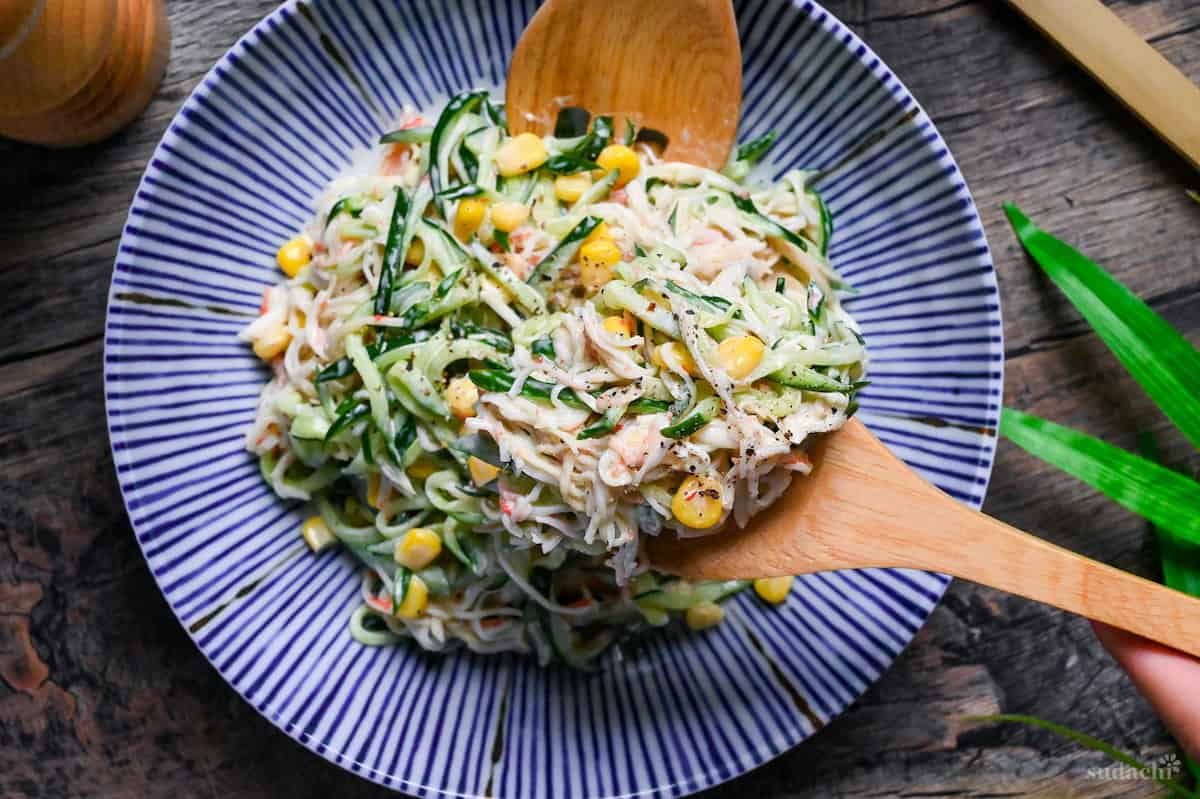
What is Kani Salad?
What started as casual sushi innovation became a cultural phenomenon. In the 1980s, a casual conveyer belt sushi chain in Japan “Kappa Sushi” began topping gunkan rolls with mayonnaise-based “salads,” creating the beloved salad gunkan that’s now standard at sushi chains nationwide.
While crab sticks (kanikama in Japanese) feature in diverse Japanese dishes like tenshinhan, harusame salad, and ehomaki (but not crab cream croquettes), this salad format lets the ingredient truly shine with restaurant-quality results.
Kani Salad Ingredients
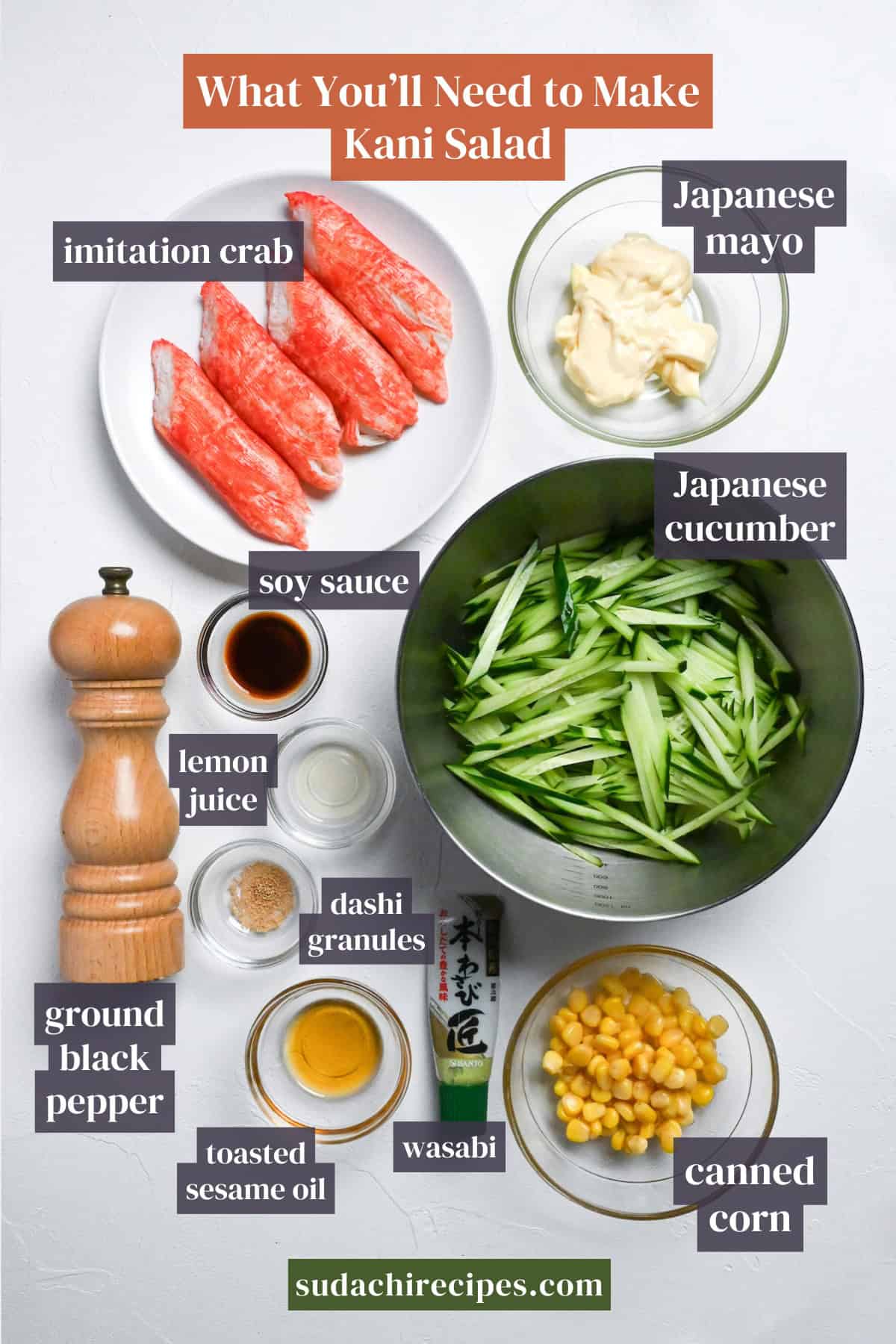
- Imitation crab (kanikama): If you prefer, you can swap in real crab meat, but kani-kama keeps things quick, budget-friendly, and authentic to how this salad is usually made in Japan.
- Japanese mayonnaise: Kewpie (in the squeeze bottle with the baby logo) is the easiest option, but if you don’t have it, you can make your own using my Kewpie mayo copycat recipe or substitute with any mayo you have on hand.
- Cucumber: I live in Japan, so I used Japanese cucumber, but if you’re not, choose English or Persian cucumbers if possible.
Substitution Ideas
- Imitation crab: Boiled shrimp, well-drained canned tuna, ham.
- Cucumber: Celery, daikon radish (check out my daikon salad recipe for the prep)
- Wasabi paste: Karashi mustard, smooth Dijon mustard, or yuzu kosho for a unique citrusy flavor profile.
Have trouble finding Japanese ingredients? Check out my ultimate guide to Japanese ingredient substitutes!
How to Make My Kani Salad
Before you start: Cut your cucumber into thin matchsticks.
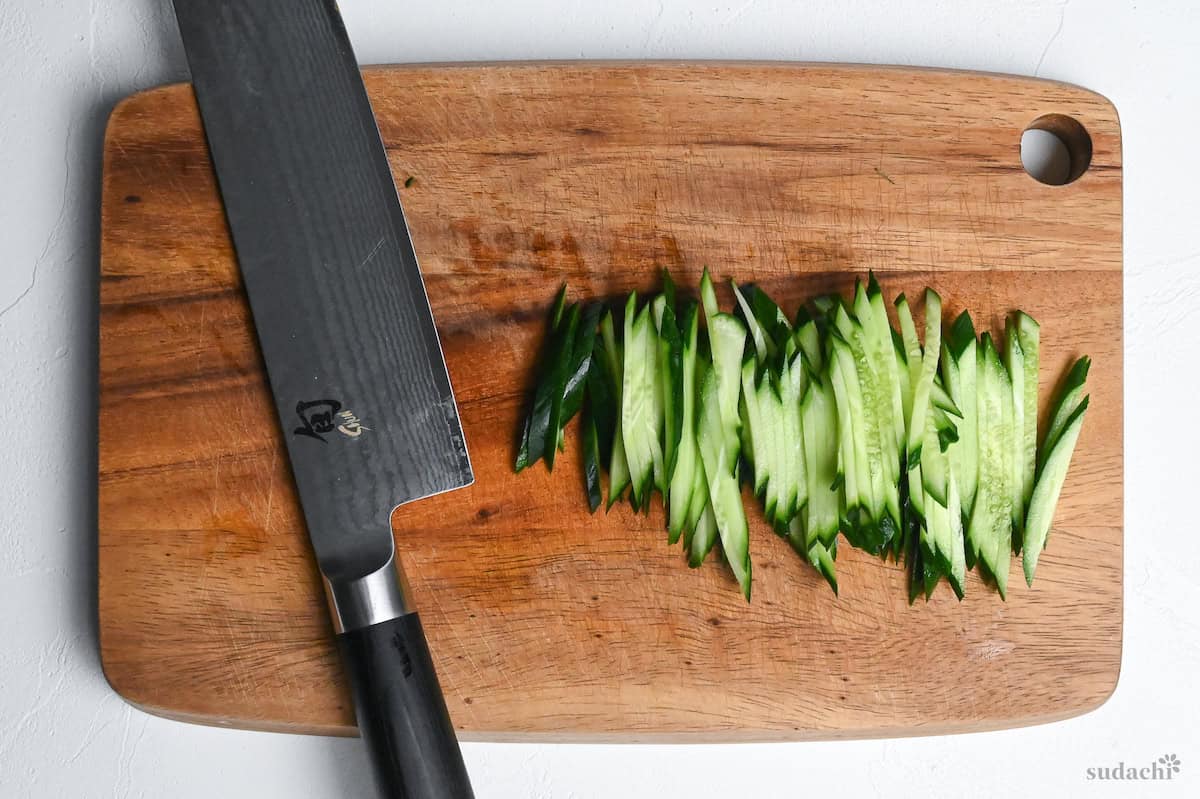
i. Salt the cucumbers (julienned) with about 2% by weight and let them sit for 5-10 minutes.
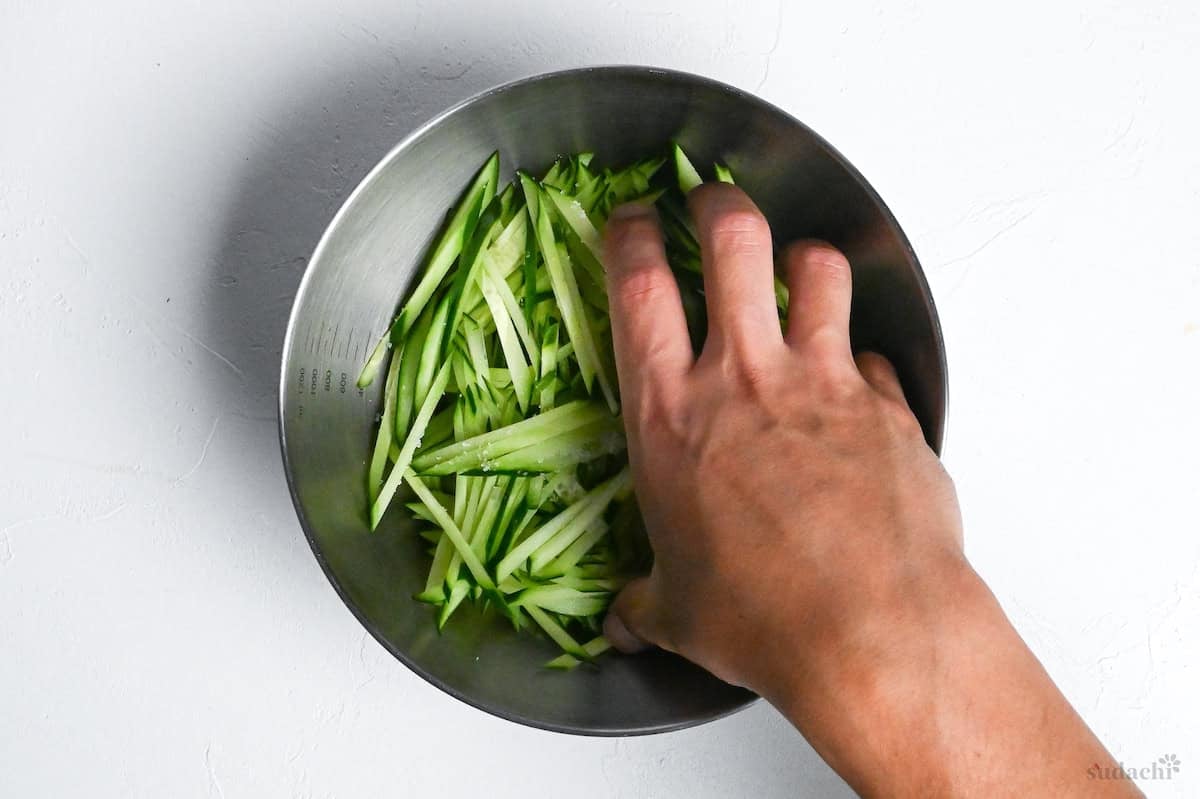
ii. After the time’s up, squeeze the cucumber strips firmly in your hands to wring out the excess water. You’ll be amazed at how much liquid comes out.
Cucumbers are 95-97% water, which means they’re basically crunchy water balloons waiting to deflate your salad. When you skip the salting step, that hidden moisture seeps out later, turning your kani salad into a watery mess.
The salt draws out cellular water through osmosis, leaving you with cucumber that stays crisp and actually absorbs the dressing instead of diluting it.
If you’re working with thick American cucumbers instead of slender Japanese ones, slice them lengthwise first and scoop out the seeds with a spoon. English cucumbers (the long, seedless variety) work beautifully here and need less prep time since they’re naturally less watery.
i. In a chilled metal bowl, break apart your imitation crab into thin, crab-like strands. Dampen your hands slightly with cool water first (this prevents the sticky crab from clinging to your fingers and makes the whole process smoother). Gently pull each stick apart lengthwise.
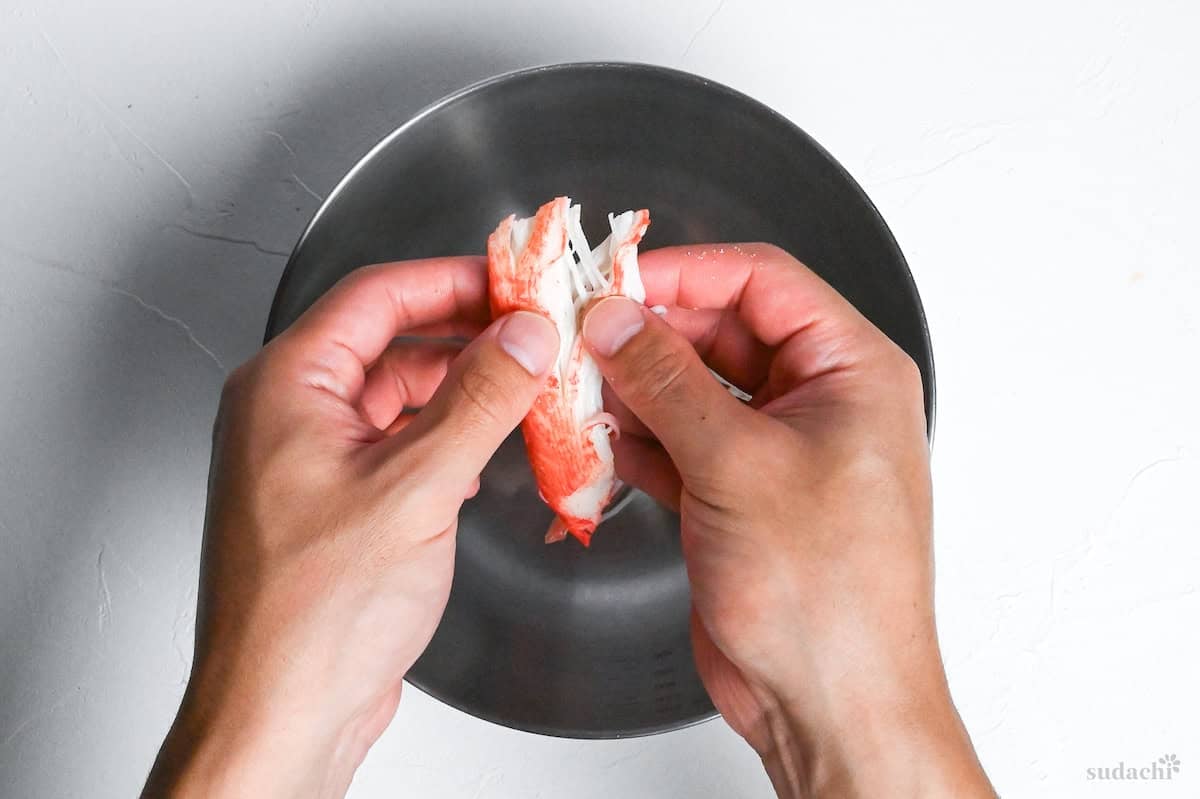
ii. Mix all the dressing ingredients (mayo, lemon juice, Japanese soy sauce, dashi granules, and wasabi paste with drained cucumber and sweet corn kernels. Mayo’s fat + salt + acid give mild kani-kama real stage presence, while fat mellows wasabi’s sharp heat so the aroma lingers without the painful punch.

iii. instead of stirring with a spoon (which crushes everything), use chopsticks or a fork to lift and fold the ingredients together. Rotate the bowl as you work, creating gentle lifting motions that coat everything evenly without breaking the delicate textures.
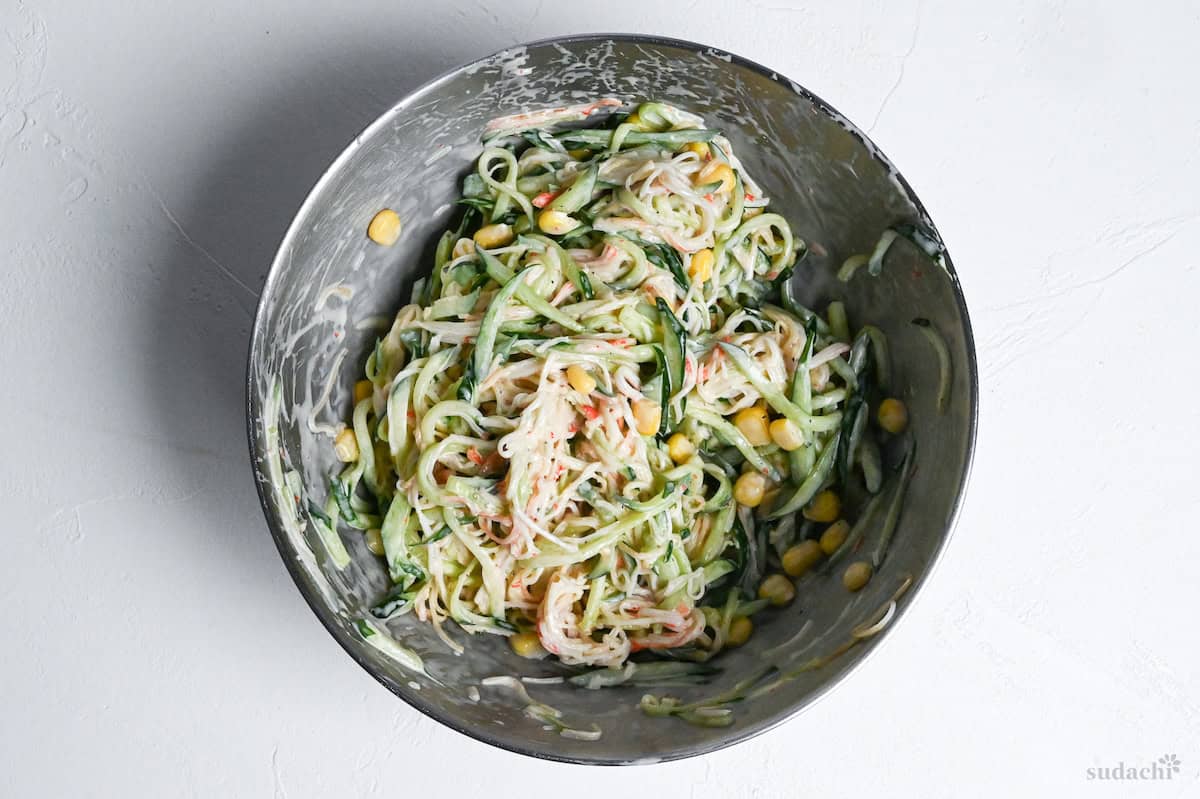
i. Right before serving, crack on black pepper and drizzle toasted sesame oil. The pepper wakes up the sweetness and the sesame oil sends a nutty aroma.
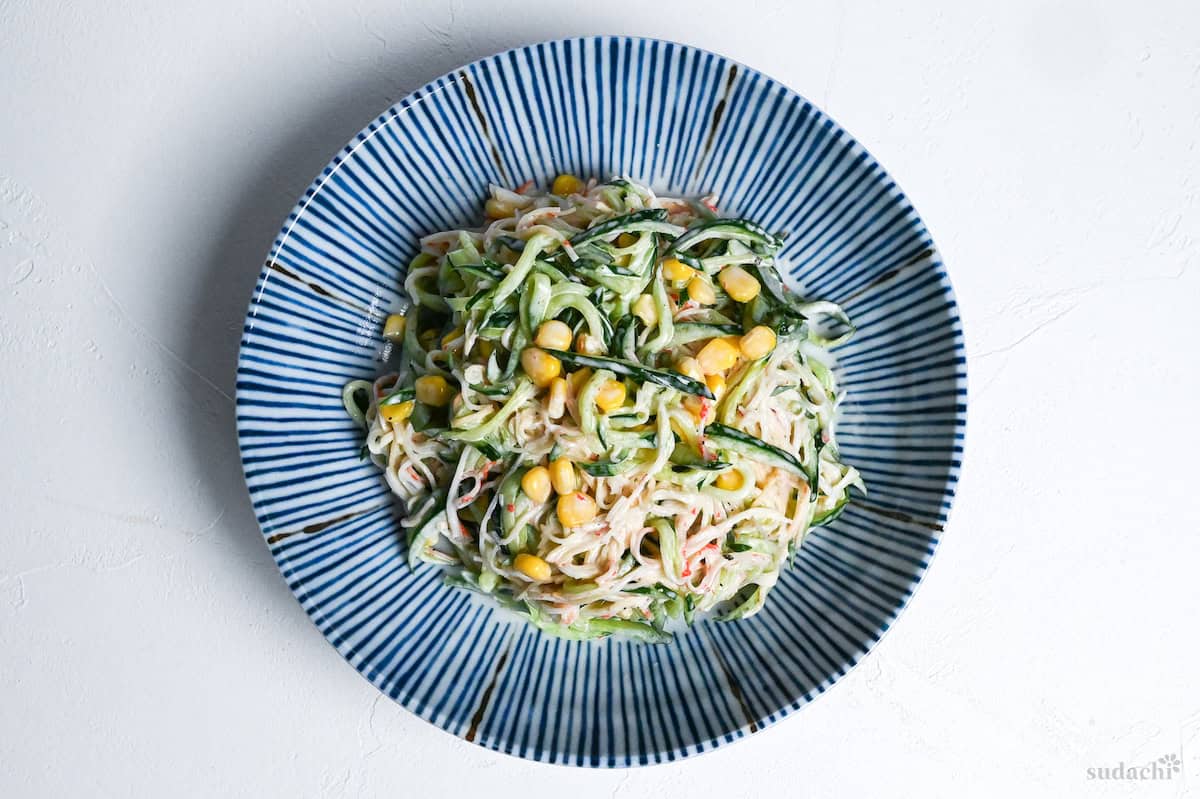
ii. Taste and adjust salt or lemon to balance if needed.

Essential Tips & Tricks
- Salt your cucumbers for up to 10 minutes to draw out excess moisture.
- Chill a metal mixing bowl beforehand.
- Hand-tear imitation crab with damp fingers.
- Drain canned corn thoroughly.
- Dress right before serving.
With these simple tips in mind, you’re set for success every time you make this kani salad.
Storage & Meal Prep
Fridge: Airtight container, 1-2 days maximum. Store components separately when possible.
Freezer: Not recommended.
Meal Prep: Not suitable, this salad is best fresh. You can only premix the dressing up to 24 hours ahead.
What to Serve With This Recipe
- Japanese Cold Tofu (Hiyayakko)
- Chicken Thighs Teriyaki
- Inari Sushi
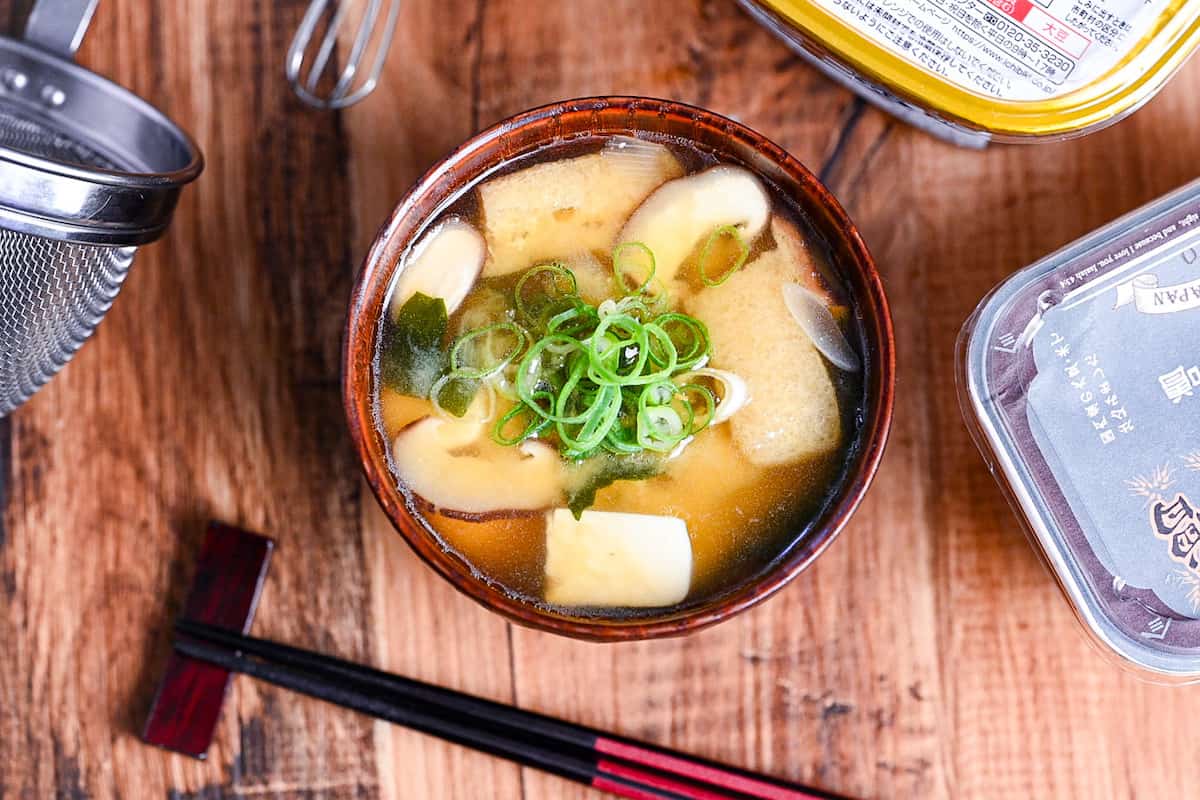
Kani Salad Q&A
This is the most common mistake. You likely didn’t salt and squeeze the cucumbers thoroughly enough, or you mixed everything too far in advance. Always salt cucumbers for exactly 10 minutes, then squeeze firmly to remove excess water. Mix the salad right before serving.
Water or over-chilling can mute flavor. Add a pinch of salt or a few drops of soy sauce/lemon. If it’s just “salty,” balance with tiny amounts of sugar and vinegar.
Change up the eating experience halfway through. Wrap portions in lettuce leaves, add different seasonings like extra wasabi or chili oil, or pair it with contrasting flavors from other dishes on your table.
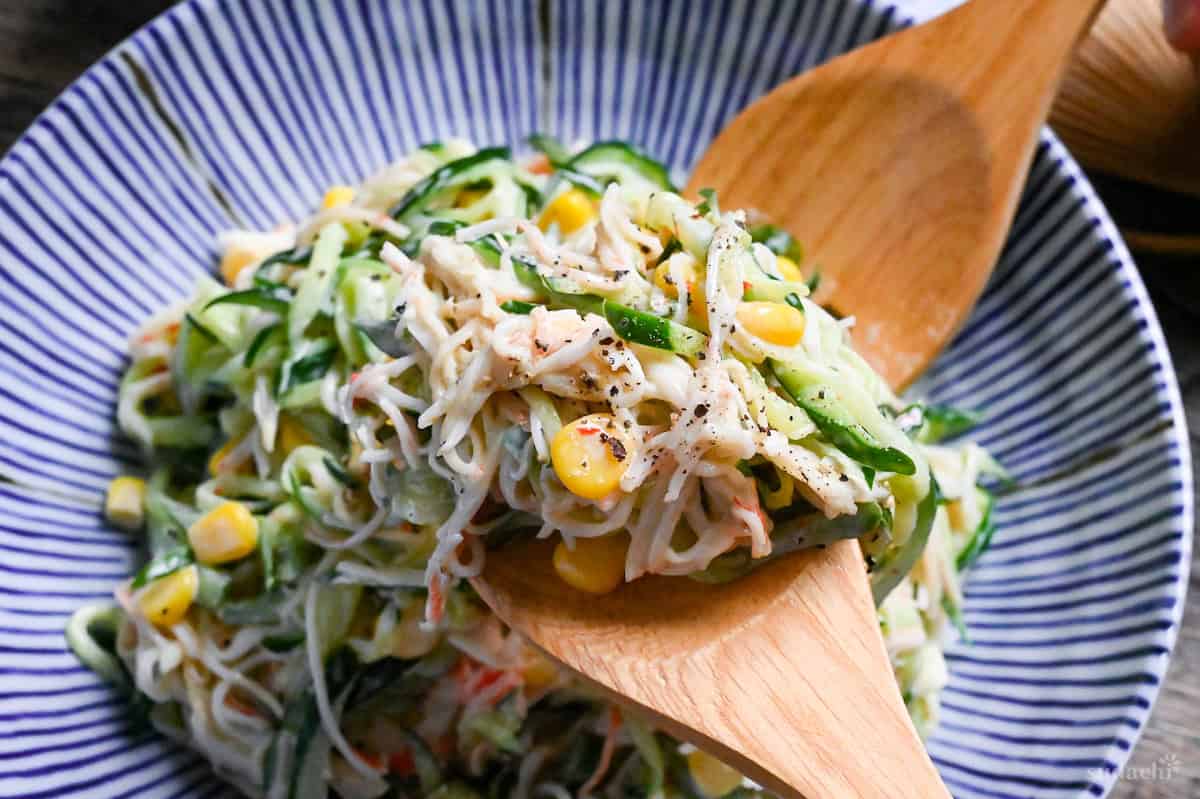
More Japanese Salad Recipes
Craving fresh ideas? These easy Japanese salad recipes are perfect for anyone seeking delicious simplicity!
Did You Try This Recipe?
I would love to hear your thoughts!
💬 Leave a review and ⭐️ rating in the comments below. 📷 I also love to see your photos – submit them here!
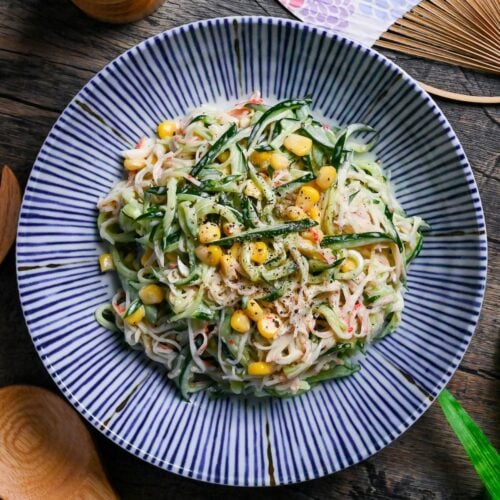
Kani Salad (Japanese Crab and Cucumber Salad)
Ingredients
- 2 Japanese cucumbers or Persian cucumbers, 1 English cucumber
- salt 2% the weight of the cucumber
- 150 g imitation crab
- 4 tbsp canned sweet corn well-drained
- ½ tsp toasted sesame oil for garnish
- ground black pepper to taste
Dressing
- 3 tbsp Japanese mayonnaise or regular mayonnaise
- 1 tsp wasabi paste start with ½ tsp if sensitive to heat
- ½ tsp lemon juice
- ½ tsp Japanese soy sauce (koikuchi shoyu)
- ⅛ tsp dashi granules
My recommended brands of ingredients and seasonings can be found in my Japanese pantry guide.
Can’t find certain Japanese ingredients? See my substitution guide here.
Instructions
- Julienne 2 Japanese cucumbers and place them in a large mixing bowl with salt (2% the weight of the cucumber). Massage until evenly coated and sit in the fridge for 10 minutes.

- Shred 150 g imitation crab by hand into a new mixing bowl (preferably chilled).

- Take the cucumber from the fridge and squeeze thoroughly to remove excess water. Place them in the bowl with the crab, then add 4 tbsp canned sweet corn (well-drained), 3 tbsp Japanese mayonnaise, 1 tsp wasabi paste, ½ tsp lemon juice, ½ tsp Japanese soy sauce (koikuchi shoyu) and ⅛ tsp dashi granules.

- Use chopsticks or a fork to gently mix everything together.

- Transfer to serving containers and drizzle with ½ tsp toasted sesame oil and a crack of ground black pepper. Enjoy!

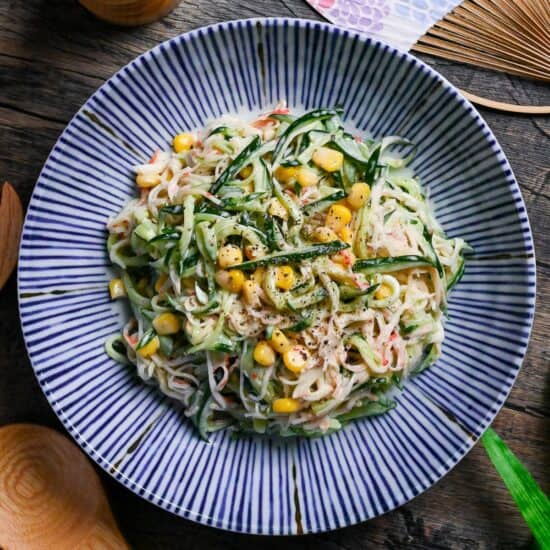


Leave a rating and a comment